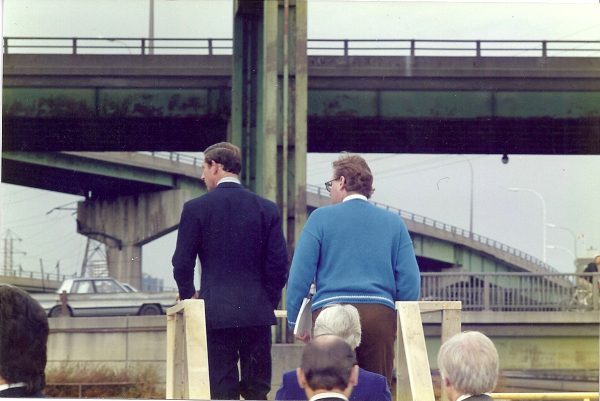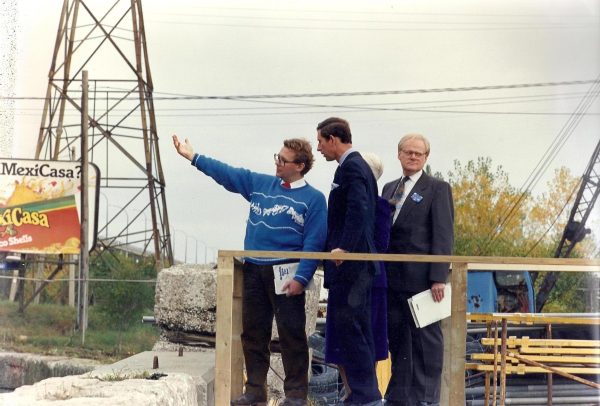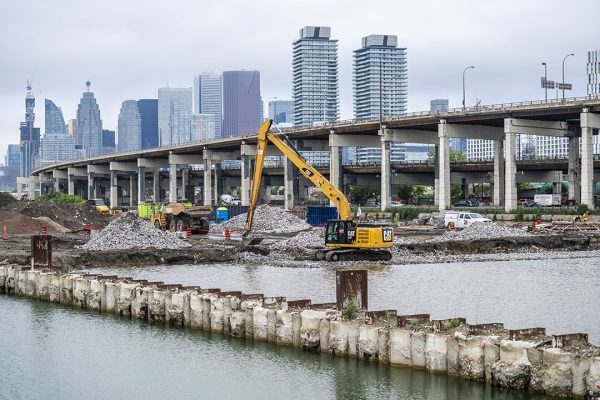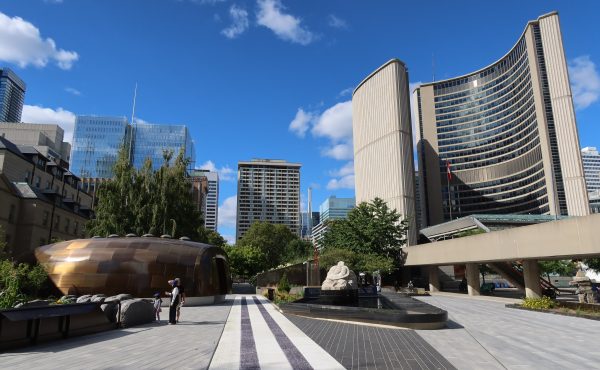In the coming weeks, Waterfront Toronto crews will remove the final plug in the new Lower Don, thereby allowing the river to finally flow naturally towards the harbour through the $1.25 billion flood protection valley constructed in the Port Lands over the past five years. (Yesterday’s epic deluge offered a timely reminder of the importance of flood protection in Toronto’s low-lying downtown.) For the first time in more than a century, the river will be able to avoid the sharp right turn that shunted the Don into the stagnant and polluted Keating Channel.
Success, as the old saying goes, has many parents, and this undertaking — an achievement that is unique to Toronto and without parallel in any other major city — is no exception. Yet much credit should flow all the way upstream, to the founders of the Taskforce to Bring Back the Don — a citizen’s group that spent well over three decades advocating for this moment.
Spacing asked Mark Wilson, one of the founders of the task force, and later a director and chair of the Waterfront Toronto board, to describe the realization of a far-fetched idea.
Spacing: So, we brought back the Don. To paraphrase the anthropologist Margaret Mead, “never doubt that a small group of thoughtful citizen can change the world…” Since you were there at the beginning, I wanted you to talk about what that beginning was like. Tell me how it began.
Mark Wilson: Well, it began for me personally in 1988, when we moved all the way across the Don River from downtown Toronto into the wilds of what now is called Riverdale. I was on the Bloor Viaduct going, “This is ridiculous. There’s this huge space, this huge river and no obvious connection to it whatsoever.”
The Globe and Mail had a Toronto magazine at the time, and they published an article called “Rebirth of a River,” by Pat Ohlendorf-Moffat. Associated with that, there was an event advertised at the Ontario Science Centre and about 500 people showed up. Towards the end of the meeting, Jack Layton stood up and said, “We’re forming a citizens’ group down at City Hall. Come on down, join us.” The initiative actually was a bit of a spin off of a Gardiner study that Jack had completed. They were turning the corner and paying attention to the Don. So in 1989, I joined a small group of people, 10 or 15, a very informal group, all of whom were interested in the project, which was supported very much by Jack Layton’s office and by the late Dan Leckie and by Barbara Hall. But very much citizen organized.
Out of that emerged a proposal to city council to establish a citizens’ task force, which got called The Don River Cleanup Interim Task Force, which just shows you the mindset at the time. You would go out and pick up some garbage and everything would be fine.
It had a staff person and a small budget. That group decided to create a vision for the Don as an important step. And it also re-labelled itself as Bring Back the Don, which was an incredibly important moment. It wasn’t “save the Don.” It wasn’t, “clean up the Don.” It was Bring Back the Don.
Spacing: It’s a great name. What do you recall about the conversation about that moniker?
Mark Wilson: The idea was that restoration was needed. It wasn’t about protecting a natural system that was unsullied and needed protection. It was a restoration movement. I don’t remember exactly who first suggested the name but it very quickly stuck. There are other parts of the Don that were about saving, up in Maple or the Charles Sauriol Reserve. But the part we were dealing with in the old City of Toronto, the lower Don, was full of infrastructure, and is still full of infrastructure.
We discovered it was quite a dump site, with ashes and cinders and all kinds of things like that, which we discovered when we created Chester Springs Marsh. There was no growth, because there was no soil. It was just very thin layer and ash underneath.
With the budget we had, the decision was made to hire a team to develop a vision. We ran an RFP process, all the good standard procurement stuff. Fortunately, Michael Hough led the team with Bob Stanbury as his hydrological guy. There was always this focus that we have the Keating Channel at the end of the Don, and this is wrong. What should we do about it? They basically proposed a marsh at the mouth of the Don, pretty much in the location where it now is, interestingly enough. It was a radical idea, and was quite poo-pooed in many quarters for a long time.
Spacing: The idea of saving a river is a hairy audacious goal, right? It’s this big space, a complicated problem, and then you’re presented with this idea about rebuilding a marsh in an industrial wasteland. What were your expectations?
Mark Wilson: It felt inevitable and necessary. Yeah, it was audacious. But everyone immediately went, “This is the right thing to do.” And, no, it won’t be done instantly. But this wasn’t just about the lower Don and it wasn’t just about the marsh. It was also proposed all the way up to Riverdale Park, in terms of dealing with the with the river, none of which ever got implemented.
Spacing: How much were you plugged into what David Crombie was doing at the time with the Royal Commission and then the Waterfront Regeneration Trust?
Mark Wilson: That’s an interesting story. We were one of the deputants at his public hearings, and we played him a song, with the famous tenor Mark Dubois singing a 19th century folk song called “Come to the Vale of the Beautiful Don.” If you speak to David and say “Mark Wilson,” the first thing that will come out of his mouth is the story about how captivating it was, and the idea that we should have a `beautiful Don’ caught his imagination. He made a decision that that was going to be an illustrative study of what he meant by regeneration. He really picked up the idea and made it respectable. I mean, if Crombie and his gang thought this was a good idea, then others took note.

Spacing: There’s been a lot of writing and material posted online about the history of the Don, the industrialization of the lower Don, Sauriol’s work, Cat’s Eye. It has become this object in the middle of the city’s culture. What do you recall knowing about that history when you started?
Mark Wilson: Not much. Much of Bring Back the Don is, in fact, a history of the Don. It was probably one of the first attempts to bring that history to light, whether it was the industrial history or the ice jams and flooding, or bare ass beach, and people swimming in the Don. There wasn’t much around at the time. In fact, I created one of the first websites at the time to make that stuff available. Collected old postcards of the Don and publicized those. In fact, in the 19th century, it was valued and treasured, a place you would put on postcards. Bring Back the Don was a way of making it apparent to people that this wasn’t just a fantasy, that this had been a reality, and that rebirth, regeneration, bringing it back, was, in fact, what should be done.
The other thing the Taskforce did from the start was illustrative small projects. At the very first tree planting we did in 1990, Ken Thomson, Lord Thomson of Fleet, picked up a shovel and was planting trees in Riverdale Park East. We were illustrating that small things could, in fact, be done. You needed to take action. We were not so much about criticizing people, but illustrating by example the fact that it could be done.
With the Chester Springs Marsh, we did a small study. We’re proposing a marsh at the mouth of the Don so we should restore a march somewhere, right? We hired a consultant, and they developed a plan, and people were going, “you’re nuts.” There’s no money to implement this plan. And we said, “if you don’t have a plan, when the money comes, you won’t be ready, right?” There’s always a new infrastructure fund. At one point, Peter Tabuns stood up at city council and said, “This is green infrastructure. We should fund this.” And they did.
So we dug a hole and filled it with some water and plants and trees. It’s kind of overgrown by now, but it was a way for us to demonstrate that, even on a small scale, you could start restoring marshes.

The other thing that Crombie did for us was that Prince Charles and Diana were visiting Toronto, and the Prince’s entourage was looking for community group to support. And they said, The Taskforce to Bring Back the Don. So I took Prince Charles on a tour of the Don. We literally built a platform at the Keating channel, and we said to him, “We’re going to put in a marsh.”
He was kind of shocked but with that collection of dignitaries and politicians, the credibility associated with that was very strong.
The other critical thing that happened was the failure of the Ataratiri project. It failed, both on soil pollution and, as importantly, on flood protection. There had never been the flood modelling for the lower Don. The provincial government [owner of the Ataratiri lands] discovered that if Hurricane Hazel hit the Don, downtown Toronto would be underwater. So flood protection suddenly came to the fore as a topic. The original Toronto Waterfront corporation’s mandate and budget included an environmental assessment to deal with flood protection.
Again, from the start, there was the idea that some kind of regeneration was what was needed. Things got slowed down in the Rob Ford era. Doug brought his ferris wheel and monorail ideas. And that was another very seminal moment, because that was really a competing set of ideas about what should happen in the Portlands. [Ford’s vision] passed executive council unanimously and was rejected at city council unanimously a couple of weeks later, because of the citizen outcry. That happened because we had done so many events, engaged so much of the public, and we had put all these positive messages out. There was a community of people that supported the idea of regeneration.
Spacing: Let me ask you the cliché journalist question: when you set out to involve yourself in this thing almost 35 years ago. did you think that there was going to be this result?
Mark Wilson: I was optimistic because the idea was so compelling. The critique of it would be, it’s impractical, can we find a cheaper solution, can we find an engineering solution? But no one said, “this is ugly, we don’t want something like this.” People would critique it on practicality, not on the core attractiveness of the idea. So it’s the old saying, that there’s nothing so compelling as an idea whose time has come. I didn’t think it would take this long, of course. But you know, once it entered the realm of accepted planning objectives, it just was a matter of, how long would it take and what was going to be the final plan?
Spacing: In Toronto, we tend to default to the cheapest solution and often not very high minded solutions when it comes to public space. Whenever I tell people about this project, I stress that it is quite dramatic and unique by any urban standards. How do you account for the fact that it was this project that got Toronto to not only think big, but act big?
Mark Wilson: Two words: Waterfront Toronto, and its commitment to design excellence. I mean, if it had been a City of Toronto Public Works project, it would have had the mediocrity that you just described. Maybe even worse,
Spacing: Where are you going to be when that last plug comes out?
Mark Wilson: I don’t know. Hopefully. we’ll have another celebratory event when the river is actually connected to the New River, and there’s lots more celebration to come.
Spacing: Any last thoughts about Margaret Mead’s adage about small groups of committed citizens?
Mark Wilson: Yeah, I think it kind of works. I think the other part of the story, though, is that we engaged the power structures and seduced them. We didn’t attempt a revolution or attack them. We seduced them, and that worked.
photos courtesy of Mark Wilson







2 comments
This group deserves the Order of Canada.
I followed Mark as chair and so totalluy agree with Spacings words. thhe Task force was a force . it was a well rhoughtout organization which was axeded by the Fords who di not support or like volunteer..organizations . . t
it has been great to see rhe Portlands project construction and to think about our effrts to keep that idea alive a and then there was David Stonehouse .
. aaS volunteers we had a huge crossection of folks who had volunteered but had ro be proposed by council..
I agree with Mark re the opiemning of the Portland’s project shouldbe celebRATED od vjolunteers should be included even if we are getting on
prosed by council . there was a political reality which worked .
s
.